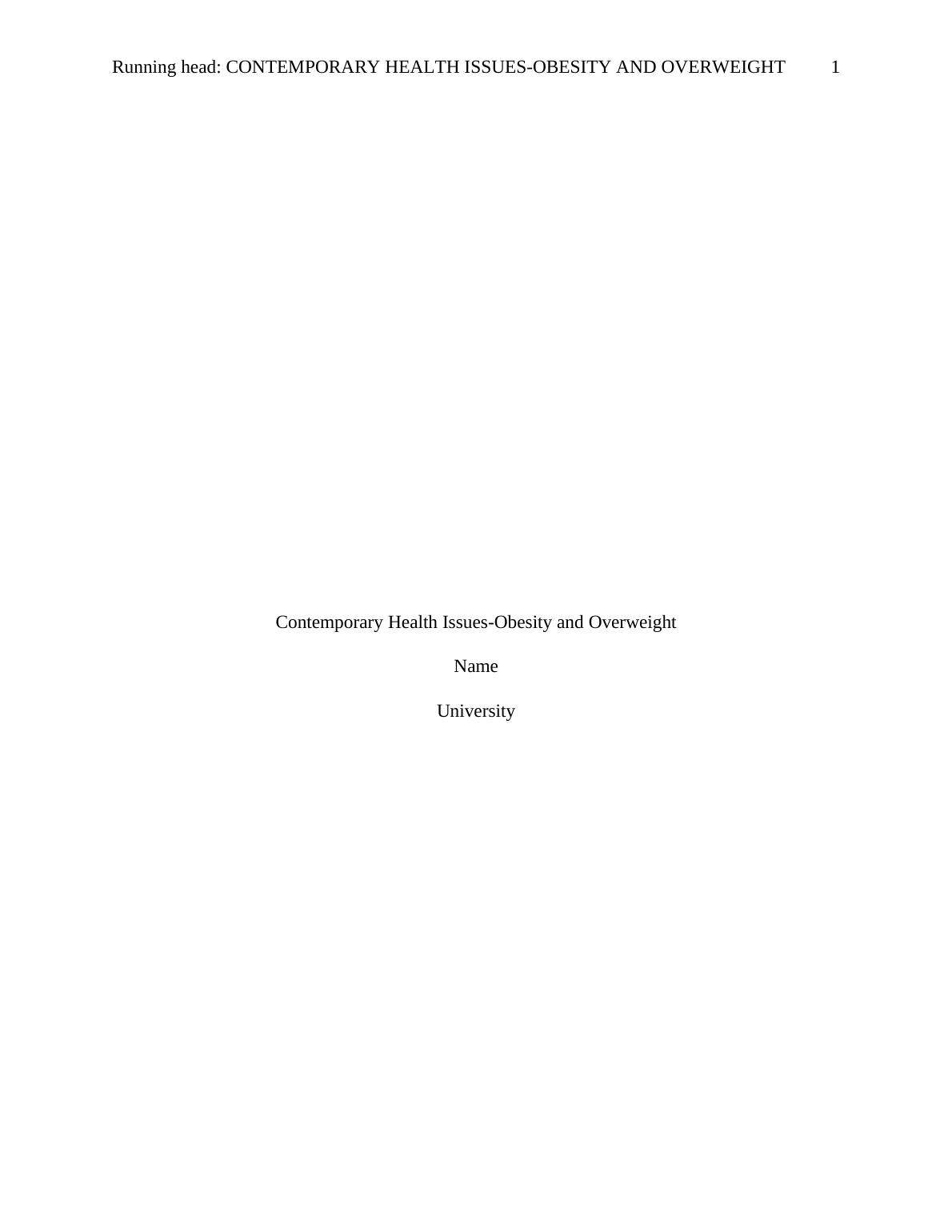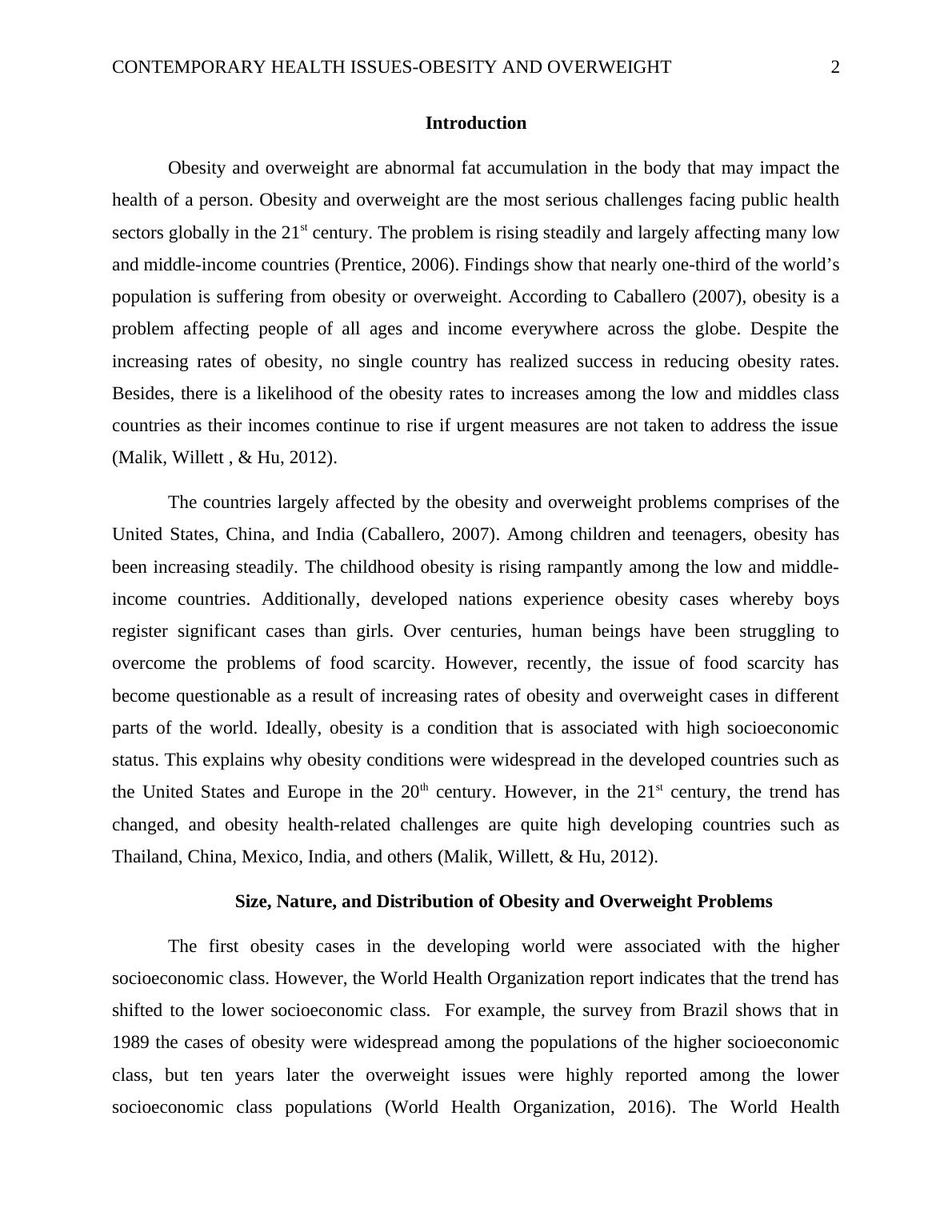Health Issues-Obesity and Overweight Assignment
Added on 2020-03-16
8 Pages2493 Words55 Views
Running head: CONTEMPORARY HEALTH ISSUES-OBESITY AND OVERWEIGHT1Contemporary Health Issues-Obesity and OverweightNameUniversity

CONTEMPORARY HEALTH ISSUES-OBESITY AND OVERWEIGHT2IntroductionObesity and overweight are abnormal fat accumulation in the body that may impact thehealth of a person. Obesity and overweight are the most serious challenges facing public healthsectors globally in the 21st century. The problem is rising steadily and largely affecting many lowand middle-income countries[ CITATION Pre06 \l 1033 ]. Findings show that nearly one-third of theworld’s population is suffering from obesity or overweight. According to Caballero (2007),obesity is a problem affecting people of all ages and income everywhere across the globe.Despite the increasing rates of obesity, no single country has realized success in reducing obesityrates. Besides, there is a likelihood of the obesity rates to increases among the low and middlesclass countries as their incomes continue to rise if urgent measures are not taken to address theissue[ CITATION Mal12 \l 1033 ]. The countries largely affected by the obesity and overweight problems comprises of theUnited States, China, and India[ CITATION Cab07 \l 1033 ]. Among children and teenagers, obesityhas been increasing steadily. The childhood obesity is rising rampantly among the low andmiddle-income countries. Additionally, developed nations experience obesity cases wherebyboys register significant cases than girls. Over centuries, human beings have been struggling toovercome the problems of food scarcity. However, recently, the issue of food scarcity hasbecome questionable as a result of increasing rates of obesity and overweight cases in differentparts of the world. Ideally, obesity is a condition that is associated with high socioeconomicstatus. This explains why obesity conditions were widespread in the developed countries such asthe United States and Europe in the 20th century. However, in the 21st century, the trend haschanged, and obesity health-related challenges are quite high developing countries such asThailand, China, Mexico, India, and others[ CITATION Mal12 \l 1033 ].Size, Nature, and Distribution of Obesity and Overweight ProblemsThe first obesity cases in the developing world were associated with the highersocioeconomic class. However, the World Health Organization report indicates that the trend hasshifted to the lower socioeconomic class. For example, the survey from Brazil shows that in1989 the cases of obesity were widespread among the populations of the higher socioeconomicclass, but ten years later the overweight issues were highly reported among the lowersocioeconomic class populations[ CITATION Wor161 \l 1033 ]. The World Health Organization

CONTEMPORARY HEALTH ISSUES-OBESITY AND OVERWEIGHT3attributes these problems in the developing countries to the existence of households withundernourished child and an overweight adult, a condition known as “dual burden” of disease. Obesity and overweight are prevalent in all population groups. However, the cases varyin different population groups. As noted earlier one-third of the world population is sufferingfrom obese and overweight health related problems. The United States leads with the 13 percentof the children and young adults suffering from obesity. Egypt leads with the adults the highestpercentage of adults with obesity[ CITATION Mee17 \l 1033 ]. The World Health Organizationreleased in 2015 indicate that 2.2 billion people are either obese or they are experiencingoverweight problems. Out of 2.2 billion people, 710 million were classified as obese with 5percent of the children and 12 percent of adults falling in this category[ CITATION Mee17 \l 1033 ].Despite the fact that the adults register high levels of obesity than the children, the researchshows the trend is shifting to children. This has raised concern about the obesity-related risks ifmeasures are not undertaken to counteract the problem.The increment of obesity among the children is largely evidenced in large populationsizes especially in India and China. The two countries have 14.4 million and 15.3 million obesechildren respectively. On the other side, the United States has the highest number of obese adultsas exhibited by 79. 4 million people, 35 percent of the population followed by China with 57.3million people. Bangladesh and Vietnam experience the lowest obesity rates each with 1 percent[CITATION Mee17 \l 1033 ]. The analysis of this World Health Organization report portrays thatfailure to employ appropriate measures to control the alarming rates of obesity, the world will begreatly affected especially by the new cases being evidenced among low and middle-incomecountries. Alternatively, obesity and overweight levels have risen in all countries irrespective ofthe socioeconomic status. This means that this health problem is not associable with thedeveloped world only but also developing economies. Therefore, it is high time the worldemployed appropriate approaches of stimulating the public on how to control the phenomenon. Effects of Obesity and OverweightThe high levels of obesity and overweight among different population groups representthe different diseases associated with these health ailments. The World Health Organizationreport observes that researchers have been raising the alarm on the increasing rates of obesitywithout creating awareness to the public on how being overweight can be fatal. According to

End of preview
Want to access all the pages? Upload your documents or become a member.
Related Documents
Overweight and Obesity as a Global Problem: Determinants, Distribution, and Preventionlg...
|8
|2489
|132
Obesity Amongst the Adult Population in NZlg...
|25
|2936
|319
The Australian’s Health Policy PDFlg...
|4
|889
|69
Overweight and Obesitylg...
|5
|1228
|151
Obesity in India Report 2022lg...
|9
|3264
|23
Obesity in Socio-Economic Groups PDFlg...
|3
|1502
|65